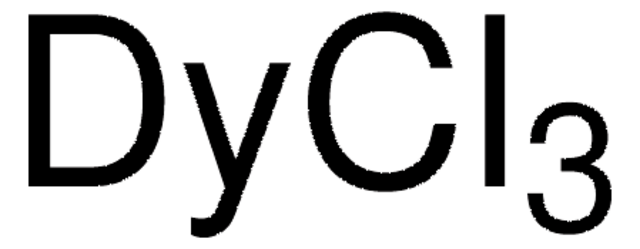261076
Dysprosium
ingot, 99.9% trace rare earth metals basis
About This Item
Polecane produkty
Próba
99.9% trace rare earth metals basis
Postać
ingot
przydatność reakcji
reagent type: catalyst
core: dysprosium
rezystywność
89 μΩ-cm, 20°C
tw
2567 °C (lit.)
mp
1412 °C (lit.)
gęstość
8.559 g/mL at 25 °C (lit.)
ciąg SMILES
[Dy]
InChI
1S/Dy
Klucz InChI
KBQHZAAAGSGFKK-UHFFFAOYSA-N
Szukasz podobnych produktów? Odwiedź Przewodnik dotyczący porównywania produktów
Powiązane kategorie
Kod klasy składowania
11 - Combustible Solids
Klasa zagrożenia wodnego (WGK)
WGK 3
Temperatura zapłonu (°F)
Not applicable
Temperatura zapłonu (°C)
Not applicable
Środki ochrony indywidualnej
Eyeshields, Gloves, type P3 (EN 143) respirator cartridges
Certyfikaty analizy (CoA)
Poszukaj Certyfikaty analizy (CoA), wpisując numer partii/serii produktów. Numery serii i partii można znaleźć na etykiecie produktu po słowach „seria” lub „partia”.
Masz już ten produkt?
Dokumenty związane z niedawno zakupionymi produktami zostały zamieszczone w Bibliotece dokumentów.
Produkty
Today, near-room-temperature refrigeration is almost entirely based on a vapor-compression refrigeration cycle.
A significant limiting factor for wearable electronics and wireless sensors is the finite amount of energy that can be stored in on-board batteries.
Istotnym czynnikiem ograniczającym elektronikę do noszenia i czujniki bezprzewodowe jest ograniczona ilość energii, którą można przechowywać w bateriach pokładowych.
Rechargeable solid-state batteries are becoming increasingly important due to wide-spread use in computers, portable electronics, and vehicular applications.
Nasz zespół naukowców ma doświadczenie we wszystkich obszarach badań, w tym w naukach przyrodniczych, materiałoznawstwie, syntezie chemicznej, chromatografii, analityce i wielu innych dziedzinach.
Skontaktuj się z zespołem ds. pomocy technicznej






